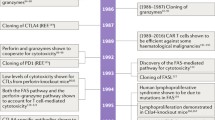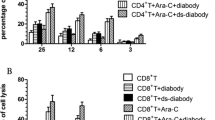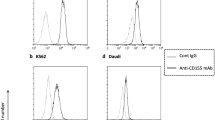Abstract
A recently developed bispecific antibody construct, directed against CD19 and CD3 (bscCD19xCD3), induces T-cell-mediated lysis of allogeneic and autologous B cells in a specific and highly efficient manner. Since knowledge of the molecular mechanisms underlying this lysis is limited, a study on bscCD19xCD3-activated T-cell-effector pathways was performed. BscCD19xCD3-induced lysis of target B-cell lines Nalm-6, Daudi, and Raji and of autologous primary B cells is caused by the perforin-dependent granule-exocytosis pathway but not by the death ligands FasL, TRAIL, or TNF-α. When activated by bscCD19xCD3 and Raji cells, T cells express FasL mRNA, but incubation of Raji cells with cell-free supernatants from cytotoxicity experiments caused an upregulation of c-Flipl, possibly accounting for the cells’ insensitivity toward death-receptor-mediated lysis. In addition to granule exocytosis, Raji cells are lysed by at least one mechanism independent of perforin, which requires transport through the T cell’s Golgi apparatus.







Similar content being viewed by others
References
Landis SH, Murray T, Bolden S, Wingo PA (1999) Cancer statistics, 1999. CA Cancer J Clin 49:8
Huhn D, von Schilling C, Wilhelm M, Ho AD, Hallek M, Kuse R, Knauf W, Riedel U, Hinke A, Srock S, Serke S, Peschel C, Emmerich B (2001) Rituximab in the treatment of patients with B-cell chronic lymphocytic leukemia. Blood 98:1326
Winkler U, Jensen M, Manzke O, Schulz H, Diehl V, Engert A (1999) Cytokine-release syndrome in patients with B-cell chronic lymphocytic leukemia and high lymphocyte counts after treatment with an anti-CD20 monoclonal antibody (Rituximab, IDEC-C2B8). Blood 94:2217
van Spriel AB, van Ojik HH, van De Winkel JG (2000) Immunotherapeutic perspective for bispecific antibodies. Immunol Today 21:391
Bauer S, Renner C, Juwana J-P, Held G, Ohnesorge S, Gerlach K, Pfreundschuh M (1999) Immunotherapy of human tumors with T-cell-activating bispecific antibodies: stimulation of cytotoxic pathways in vivo. Cancer Res 59:1961
Renner C, Held G, Ohnesorge S, Bauer S, Gerlach K, Pfitzenmeier J-P, Pfreundschuh M (1997) Role of naive and memory T cells in tumor cell lysis mediated by bi-specific antibodies. Immunobiol 197:122
Renner C, Held G, Ohnesorge S, Bauer S, Gerlach K, Pfitzenmeier J-P, Pfreundschuh M (1997) Role of perforin, granzymes and the proliferative state of the target cells in apoptosis and necrosis mediated by bispecific-antibody-activated cytotoxic T cells. Cancer Immunol Immunother 44:70
Manzke O, Berthold F, Huebel K, Tesch H, Diehl V, Bohlen H (1999) CD3xCD19 bispecific antibodies and CD28 bivalent antibodies enhance T-cell reactivity against autologous leukemic cells in pediatric B-ALL bone marrow. Int J Cancer 80:715
Zeidler R, Mayer A, Gires O, Schmitt B, Mack B, Lindhofer H, Wollenberg B, Walz A (2001) TNFα contributes to the antitumor activity of a bispecific, trifunctional antibody. Anticancer Res 21:3499
Dreier T, Lorenczewski G, Brandl C, Hoffmann P, Syring U, Hanakam F, Kufer P, Riethmüller G, Bargou RC, Baeuerle PA (2002) Extremely potent, rapid and costimulation-independent cytotoxic T-cell response against lymphoma cells catalyzed by a single-chain bispecific antibody. Int J Cancer 100:690
Dreier T, Baeuerle PA, Fichtner I, Grün M, Schlereth B, Lorenczewski G, Kufer P, Lutterbüse R, Riethmüller G, Gjorstrup P, Bargou RC (2003) T cell costimulus-independent and very efficacious inhibition of tumor growth in mice bearing subcutaneous or leukemic human B cell lymphoma xenografts by a CD19-/CD3-bispecific single-chain antibody construct. J Immunol 170:4397
Löffler A, Kufer P, Lutterbüse R, Zettl F, Daniel PT, Schwenkenbecher JM, Riethmüller G, Dörken B, Bargou RC (2000) A recombinant bispecific single-chain antibody, CD19xCD3, induces rapid and high lymphoma-directed cytotoxicity by unstimulated T lymphocytes. Blood 95:2098
Löffler A, Grün M, Wuchter C, Schriever F, Kufer P, Dreier T, Hanakam F, Baeuerle PA, Bommert K, Karawajew L, Dörken B, Bargou RC (2003) Efficient elimination of chronic lymphocytic leukaemia B cells by autologous T cells with a bispecific anti-CD19/anti-CD3 single-chain antibody construct. Leukemia 17:900
Russell JH, Ley TJ (2002) Lymphocyte-mediated cytotoxicity. Annu Rev Immunol 20:323
Shi L, Kraut RP, Aebersold R, Greenberg AH (1992) A natural killer cell granule protein that induces DNA fragmentation and apoptosis. J Exp Med 175:553
Froelich CJ, Orth K, Turbov J, Seth P, Gottlieb R, Babior B, Shah GM, Bleackley RC, Dixit VM, Hanna W (1996) New paradigm for lymphocyte granule-mediated cytotoxicity. Target cells bind and internalize granzyme B, but an endosomolytic agent is necessary for cytosolic delivery and subsequent apoptosis. J Biol Chem 271:29073
Krammer PH (2000) CD95’s deadly mission in the immune system. Nature 407:789
Kataoka T, Shinohara N, Takayama H, Takaku K, Kondo S, Yonehara S, Nagai K (1996) Concanamycin A, a powerful tool for characterization and estimation of contribution of perforin- and Fas-based lytic pathways in cell-mediated cytotoxicity. J Immunol 156:3678
Kayagaki N, Yamaguchi N, Nakayama M, Kawasaki A, Akiba H, Okumura K, Yagita H (1999) Involvement of TNF-related apoptosis-inducing ligand in human CD4+ T cell-mediated cytotoxicity. J Immunol 162:2639
Chatterjee D, Schmitz I, Krueger A, Yeung K, Kirchhoff S, Krammer PH, Peter ME, Wyche JH, Pantazis P (2001) Induction of apoptosis in 9-nitrocamptothecin-treated DU145 human prostate carcinoma cells correlates with de novo synthesis of CD95 and CD95 ligand and down-regulation of c-FLIP(short). Cancer Res 61:7148
Cinatl J Jr, Blaheta R, Bittoova M, Scholz M, Marraf S, Vogel JU, Cinatl J, Doerr HW (2000) Decreased neutrophil adhesion to human cytomegalovirus-infected retinal pigment epithelial cells is mediated by virus-induced up-regulation of Fas ligand independent of neutrophil apoptosis. J Immunol 165:4405
Trapani JA, Davis J, Sutton VR, Smyth MJ (2000) Proapoptotic functions of cytotoxic lymphocyte granule constitutents in vitro and in vivo. Curr Op Immunol 12:323
Hennino A, Berard M, Casamayor-Palleja M, Krammer PH, Defrance T (2000) Regulation of the Fas death pathway by FLICE-inhibitory protein in primary human B cells. J Immunol 165:3023
Di Somma MM, Somma F, Montani MS, Mangiacasale R, Cundari E, Piccolella E (1999) TCR engagement regulates differential responsiveness of human memory T cells to Fas (CD95)-mediated apoptosis. J Immunol 162:3851
De Gast GC, Haagen I-A, van Houten AA, Klein SC, Duits AJ, de Weger RA, Vroom TM, Clark MR, Phillips J, van Dijk AJG, de Lau WBM, Bast BJEG (1995) CD8 T cell activation after intravenous administration of CD3xCD19 bispecific antibody in patients with non-Hodgkin lymphoma. Cancer Immunol Immunother 40:390
Tibben JG, Boerman OC, Claessens RAMJ, Corstens FHM, van Deuren M, de Mulder PHM, van der Meer JWM, Keijser KGG, Massuger LFAG (1993) Cytokine release in an ovarian carcinoma patient following intravenous administration of bispecific antibody OC/TR F(AB’)2. J Natl Cancer Inst 85:1003
Mack M, Gruber R, Schmidt S, Riethmüller G, Kufer P (1997) Biologic properties of a bispecific single-chain antibody directed against 17-1A (EpCAM) and CD3: tumor cell-dependent T cell stimulation and cytotoxic activity. J Immunol 158:3965
Rothstein TL (2000) Inducible resistance to Fas-mediated apoptosis in B cells. Cell Res 10:245
Yasukawa M, Ohminami H, Arai J, Kasahara Y, Ishida Y, Fujita S (2000) Granule exocytosis, and not the fas/fas ligand system, is the main pathway of cytotoxicity mediated by alloantigen-specific CD4(+) as well as CD8(+) cytotoxic T lymphocytes in humans. Blood 95:2352
Acknowledgements
We thank Micromet AG, Munich, for providing the bscCD19xCD3 used in this study.
Author information
Authors and Affiliations
Corresponding author
Additional information
This investigation was supported by the Deutsche Forschungsgemeinschaft, Klinische Forschergruppe, grant no. KFO 105/1.
Rights and permissions
About this article
Cite this article
Gruen, M., Bommert, K. & Bargou, R.C. T-cell-mediated lysis of B cells induced by a CD19xCD3 bispecific single-chain antibody is perforin dependent and death receptor independent. Cancer Immunol Immunother 53, 625–632 (2004). https://doi.org/10.1007/s00262-003-0496-2
Received:
Accepted:
Published:
Issue Date:
DOI: https://doi.org/10.1007/s00262-003-0496-2




